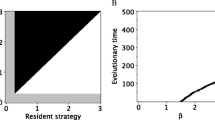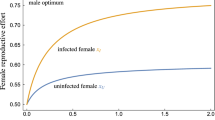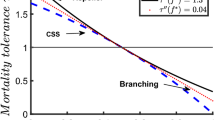Abstract
Infectious diseases affect many populations and it should be natural to avoid contacts with infected individuals to prevent contagion. Recognizability of infected individuals is essential for infection avoidance. In the case of sexually transmitted infections, such avoidance is accomplished by choosing a healthy mating partner. We find that different mating strategies arise as a consequence of evolution of infection avoidance. Considering infection avoidance as host willingness to accept infection risk upon encountering a potential yet infected mating partner, we show that evolutionary bistability occurs: either no avoidance evolves or a degree of avoidance is attained at which the host population ends up disease-free. In the latter case, evolutionary suicide may even occur so that the host population goes extinct. Infection avoidance may also be driven by a degree of infection visibility and therefore thought of as a parasite trait. In that case, parasite crypticity (and hence no avoidance) evolves provided there is no cost on the degree of infection (non-)visibility. Considering a virulence-visibility trade-off leads to parasite crypticity, too, and no virulence. On the other hand, an intermediate degree of infection visibility becomes an evolutionary attractor if a transmissibility-visibility trade-off is adopted, or when the transmissibility-visibility trade-off and the virulence-visibility trade-off act simultaneously.





Similar content being viewed by others
References
Antonovics J, Boots M, Abbate J, Baker C, McFrederick Q, Panjeti V (2011) Biology and evolution of sexual transmission. Ann N Y Acad Sci. 1230:12–24. https://doi.org/10.1111/j.1749-6632.2011.06127.x
Ashby B, Boots M (2015) Coevolution of parasite virulence and host mating strategies. Proceedings of the National Academy of Sciences 112:13290–13295. https://doi.org/10.1073/pnas.1508397112
Berec L, Maxin D (2013) Fatal or harmless: extreme bistability induced by sterilizing, sexually transmitted pathogens. Bull Math Biol. 75:258–273. https://doi.org/10.1007/s11538-012-9802-5
Berec L, Maxin D (2014) Why have parasites promoting mating success been observed so rarely? J Theor Biol. 342:47–61. https://doi.org/10.1016/j.jtbi.2013.10.012
Berec L, Janoušková E, Theuer M (2017) Sexually transmitted infections and mate-finding allee effects. Theor Popul Biol. 114:59–69. https://doi.org/10.1016/j.tpb.2016.12.004
Boots M, Knell RJ (2002) The evolution of risky behaviour in the presence of a sexually transmitted disease. Proceedings of the Royal Society B 269:585–589. https://doi.org/10.1098/rspb.2001.1932
de Castro F, Bolker B (2005) Mechanisms of disease-induced extinction. Ecol Lett. 8:117–126. https://doi.org/10.1111/j.1461-0248.2004.00693.x
Caswell H, Weeks DE (1986) Two-sex models: chaos, extinction, and other dynamic consequences of sex. The American Naturalist 128:707–735
Dieckmann U (2002) Adaptive dynamics of pathogen-host interactions. In: Dieckmann U, Metz JAJ, Sabelis MW, Sigmund K (eds) Adaptive dynamics of infectious diseases. Cambridge University Press, Cambridge, UK, pp 39–59
Geritz SAH, Kisdi E, Meszena G, Metz JAJ (1998) Evolutionarily singular strategies and the adaptive growth and branching of the evolutionary tree. Evol Ecol. 12:35–57. https://doi.org/10.1023/A:1006554906681
Hamilton WD, Zuk M (1982) Heritable true fitness and bright birds: a role for parasites? Science 218:384–387. https://doi.org/10.1126/science.7123238
Knell RJ (1999) Sexually transmitted disease and parasite-mediated sexual selection. Evolution 53:957–961. https://doi.org/10.2307/2640735
Knell RJ, Webberley KM (2004) Sexually transmitted diseases of insects: distribution, evolution, ecology and host behaviour. Biol Rev. 79:557–581. https://doi.org/10.1017/S1464793103006365
Kokko H, Ranta E, Ruxton G, Lundberg P (2002) Sexually transmitted disease and the evolution of mating systems. Evolution 56:1091–1100. https://doi.org/10.1111/j.0014-3820.2002.tb01423.x
Kot M (2001) Elements of mathematical ecology. Cambridge University Press
Lindström J, Kokko H (1998) Sexual reproduction and population dynamics: the role of polygyny and demographic sex differences. Proceedings of the Royal Society B 265:483–488. https://doi.org/10.1098/rspb.1998.0320
Lockhart AB, Thrall PH, Antonovics J (1996) Sexually transmitted diseases in animals: ecological and evolutionary implications. Biol Rev. 71:415–471. https://doi.org/10.1111/j.1469-185X.1996.tb01281.x
McCallum H (2012) Disease and the dynamics of extinction. Philos Trans Royal Soc B. 367:2828–2839. https://doi.org/10.1098/rstb.2012.0224
McCallum H, Dobson A (1995) Detecting disease and parasite threats to endangered species and ecosystems. Trends Ecol Evol. 10:190–194. https://doi.org/10.1016/S0169-5347(00)89050-3
Miller TEX, Inouye BD (2011) Confronting two-sex demographic models with data. Ecology 92:2141–2151. https://doi.org/10.1890/11-0028.1
Rankin DJ, Kokko H (2007) Do males matter? the role of males in population dynamics. Oikos 116:335–348. https://doi.org/10.1111/j.0030-1299.2007.15451.x
Theuer M, Berec L (2018) Impacts of infection avoidance for populations affected by sexually transmitted infections. J Theor Biol. 455:64–74. https://doi.org/10.1016/j.jtbi.2018.06.030
Thrall PH, Antonovics J, Dobson AP (2000) Sexually transmitted diseases in polygynous mating systems: prevalence and impact on reproductive success. Proceedings of the Royal Society B 267:1555–1563. https://doi.org/10.1098/rspb.2000.1178
Tybur JM, Gangestad SW (2011) Mate preferences and infectious disease: theoretical considerations and evidence in humans. Philos Trans Royal Soc B. 366:3375–3388. https://doi.org/10.1098/rstb.2011.0136
Acknowledgements
MT acknowledges institutional support MUNI/A/1418/2019.
Author information
Authors and Affiliations
Corresponding author
Ethics declarations
Conflicts of interest
The authors declare that they have no conflict of interest.
Appendices
Appendix 1
Development of model 1
Here we derive model (1) of the main text (see also Berec and Maxin, 2013; Theuer and Berec, 2018). Let \(\mathcal {M}(N_F,N_M)\) denote the rate at which females of density \(N_F\) and males of density \(N_M\) mate; it is also called a mating function. Dynamics of female and male populations is then commonly modeled as (Caswell and Weeks, 1986; Lindström and Kokko, 1998; Kot, 2001; Rankin and Kokko, 2007)
The term \((bw/2)\mathcal {M}(N_F,N_M)\), common for both equations, stands for reproduction: w is the proportion of matings that result in reproduction, b is the number of offspring per reproductive event, and 1/2 stems from assuming a 1:1 sex ratio at birth. The second term in both equations stands for mortality, where \(\mu _F\) and \(\mu _M\) represent the per-capita background mortality rate of females and males, respectively. Total mortality is further modulated by a crowding factor d; \(N=N_F+N_M\) is the total population density.
We now extend model 36 to account for a sexually transmitted infection (STI). To do this, we split female and male populations into two subclasses: susceptible individuals currently free of infection but prone to getting it (denoting by \(S_F\) and \(S_M\) the respective classes of susceptible individuals) and infected individuals which are infectious and may infect susceptible ones upon mating (denoting by \(I_F\) and \(I_M\) the respective classes of infected individuals). Females and males are assumed to mate randomly at a total rate \(\mathcal {M}(S_F+I_F,S_M+I_M)\). Because \(X/(S_F+I_F)\) is the proportion of females of type X among all females and \(Y/(S_M+I_M)\) is the proportion of males of type Y among all males, the rate at which females of class X (where X is \(S_F\) or \(I_F\)) mate with males of class Y (where Y is \(S_M\) or \(I_M\)) is
Upon mating between a susceptible female and an infected male, the STI is transmitted with probability \(\xi _M\), hence the force of infection for the susceptible female is
Similarly, upon mating between an infected female and a susceptible male, the infection is transmitted with probability \(\xi _F\), hence the force of infection for the susceptible male is
Finally, the STI is assumed to increase the per-capita mortality of infected females and males by \(\alpha _F\) and \(\alpha _M\), respectively, and to decrease the per-capita fertility of infected females and males by factors \(\sigma _F\) and \(\sigma _M\), respectively. With all this, we can write our sex-structured SI (susceptible-infected) model as is the total per-female per-male mating rate.
where
One of our main assumptions is that susceptible individuals are willing to mate with infected individuals with a probability \(\psi\). Because of this, we modify model 40 and have
where
We further assume, in line with most published epidemiological models, that female and male life histories are identical and hence that model parameters are sex-independent. Setting \(\mu _F=\mu _M=\mu\), \(\sigma _F=\sigma _M=\sigma\), \(\xi _F=\xi _M=\xi\), and \(\alpha _F=\alpha _M=\alpha\), it follows that \(S_M = S_F = S/2\) where \(S = S_M + S_F\) and \(I_M = I_F = I/2\) where \(I = I_M + I_F\) (provided that this also holds for the respective initial conditions). Summing equations for \(S_F\) and \(S_M\) and for \(I_F\) and \(I_M\) the sex-structured model 42 then reduces to the following unstructured SI model:
where \(N=S+I\).
Next we assume, in line with many published sex-structured models, that the mating function \(\mathcal {M}(N_F,N_M)\) is degree-one homogeneous, that is,
for any positive number x, y, a (Caswell and Weeks 1986; Miller and Inouye, 2011). We thus have \(\mathcal {M}(N/2,N/2) = (N/2) \mathcal {M}(1,1)\) and model 44 becomes
Finally, denoting \(\beta = (bw/2)\mathcal {M}(1,1)\) and \(\lambda = \xi \mathcal {M}(1,1)\), which are both compound parameters, we eventually get
And this is exactly model 1 in the main text.
Appendix 2
Evolutionary singular point in case of evolution from host perspective
Non-sterilizing infections
With no sterilization (\(\sigma =0\)), the resident-only model 1 can be rewritten in terms of the total population density \(N=S+I\) and the infection prevalence \(i=I/N\) as
Since the second equation in model 48 does not depend on N, the infection prevalence equilibria are \(i^*_1=0\) and then \(i^*_2\) and \(i^*_3\) as solutions of equation
satisfying \(0 < i_{2,3}^* \le 1\). From the evolutionary perspective, we are only interested in the stable resident-only endemic equilibrium, which is
where \(\Delta = (2\beta (1-\psi )-\lambda \psi +\alpha )^2 + 8\beta (1-\psi )(\lambda \psi -\alpha -\beta )\) (Theuer and Berec, 2018). Existence and stability conditions are provided as expressions 11 in the main text, where we denote \(N^*_3\) as \(N^*\) and \(i^*_3\) as \(i^*\).
For the evolutionary singular point \(\psi ^*\) it holds that
which is derived in the main text as formula 9. Since \(i^*_3\) is one of the solutions of equation 49, by plugging the formula 51 into the equation 49 we get an equation for the evolutionary singular point \(\psi ^*\). The result is a quadratic equation in \(\psi ^*\), with roots
Since both \(i^*_3\) (for stable endemic equilibrium) and \(i^*_2\) (for unstable equilibrium) are roots of 49, one of \(\psi ^*_1\) and \(\psi ^*_2\) corresponds to stable and one to unstable equilibrium. Plugging \(\psi ^*_2\) into 51 we get \(i^*_3(\psi ^*_2) = 0\), thus not an endemic equilibrium. Therefore, the evolutionary singular point \(\psi ^*\), corresponding to stable endemic equilibrium, is \(\psi ^*_1\).
Partially sterilizing infections
For partially sterilizing infections (\(0<\sigma <1\)) we follow similar calculations , which are however more complicated. The resident-only model 1 can be rewritten in terms of the total population density \(N=S+I\) and the infection prevalence \(i=I/N\) as
where \(X= \sigma -i \sigma ^2/2 +(1-\sigma )(1-\psi )(1-i)\). Again, since the second equation in model 53 does not depend on N, the infection prevalence equilibria are \(i^*_1=0\) and then \(i^*_2\) and \(i^*_3\) as solutions of equation (again provided that \(0 < i_{2,3}^* \le 1\))
Equation 9 also holds for the evolutionary singular point \(\psi ^*\) in partially sterilizing infections. Plugging the formula 9 into 54, we get an equation for the evolutionary singular point \(\psi ^*\). As for non-sterilizing infections, the result is a quadratic equation in \(\psi ^*\), which now has roots
Plugging \(\psi ^*_2\) into 9 we get \(i^*(\psi ^*_2) = 0\), thus not an endemic equilibrium. Therefore the evolutionary singular point \(\psi ^*\), corresponding to stable endemic equilibrium, is \(\psi ^*_1\).
Rights and permissions
About this article
Cite this article
Theuer, M., Berec, L. Evolution of infection avoidance in populations affected by sexually transmitted infections. Theor Ecol 14, 233–246 (2021). https://doi.org/10.1007/s12080-020-00494-3
Received:
Accepted:
Published:
Issue Date:
DOI: https://doi.org/10.1007/s12080-020-00494-3




